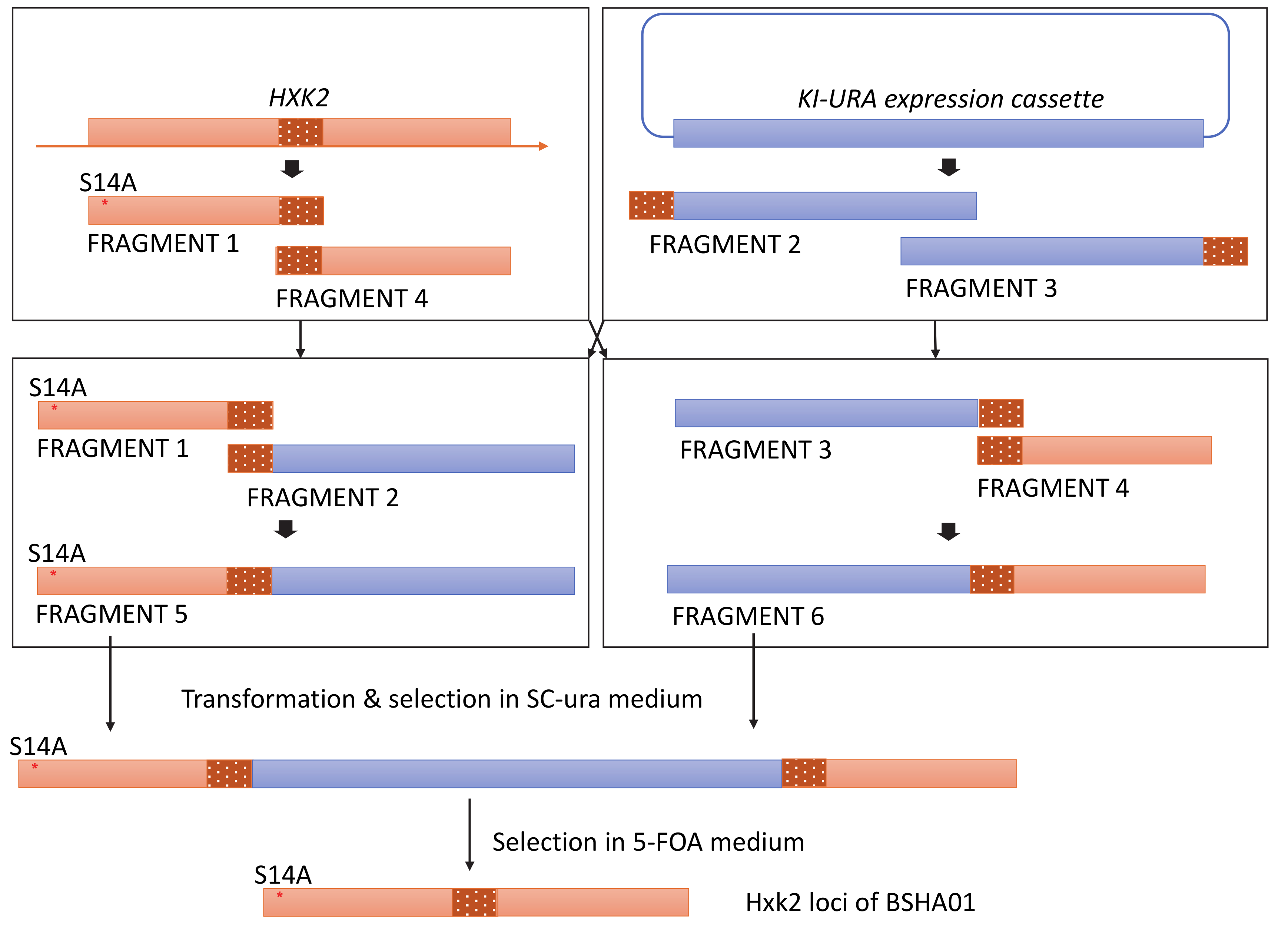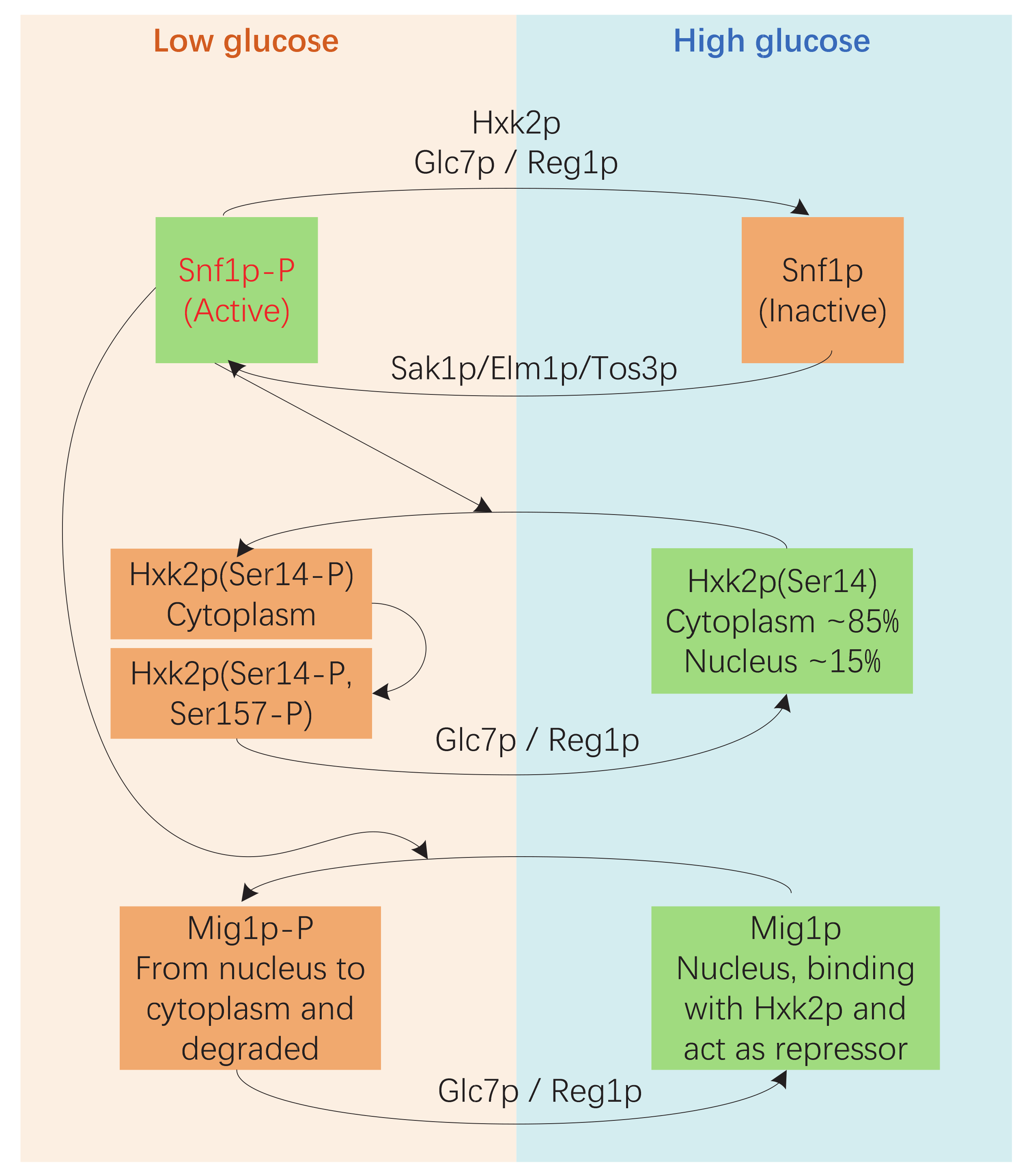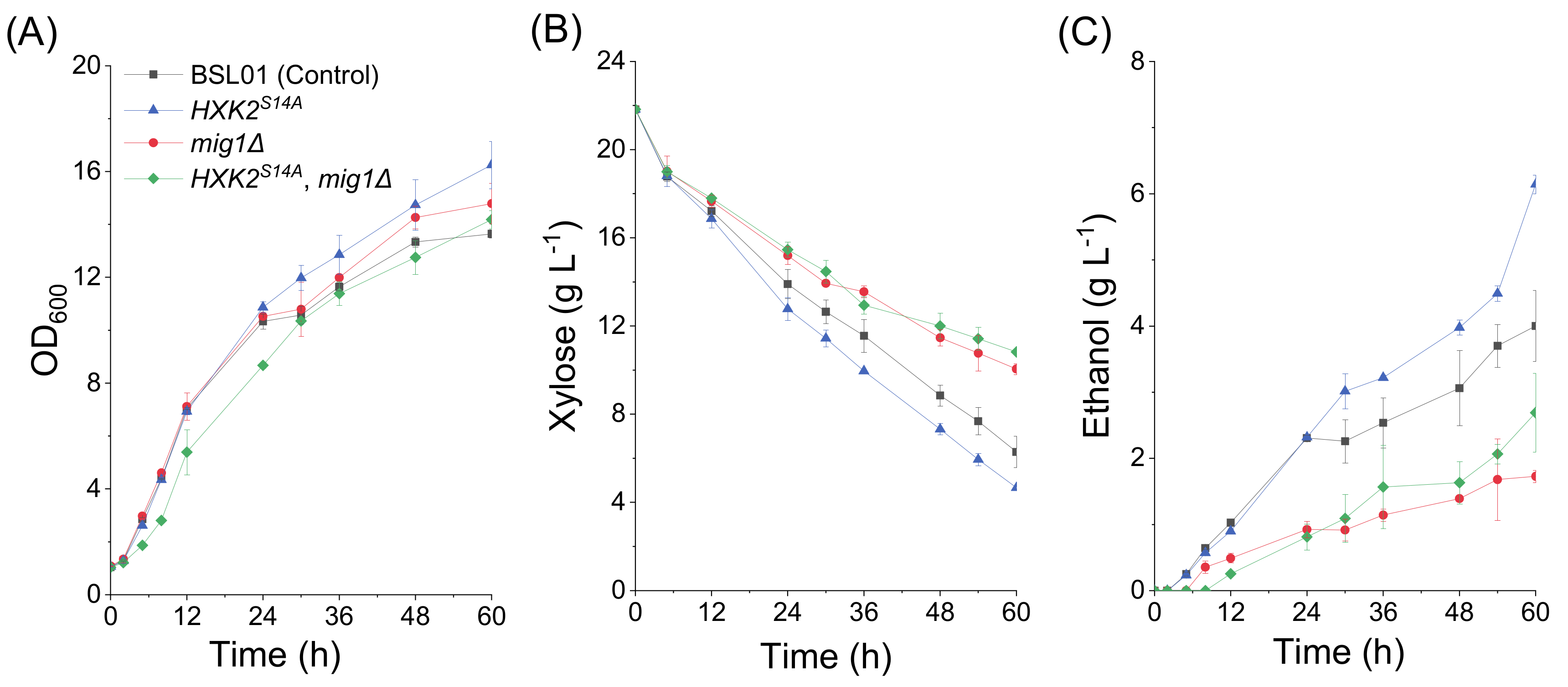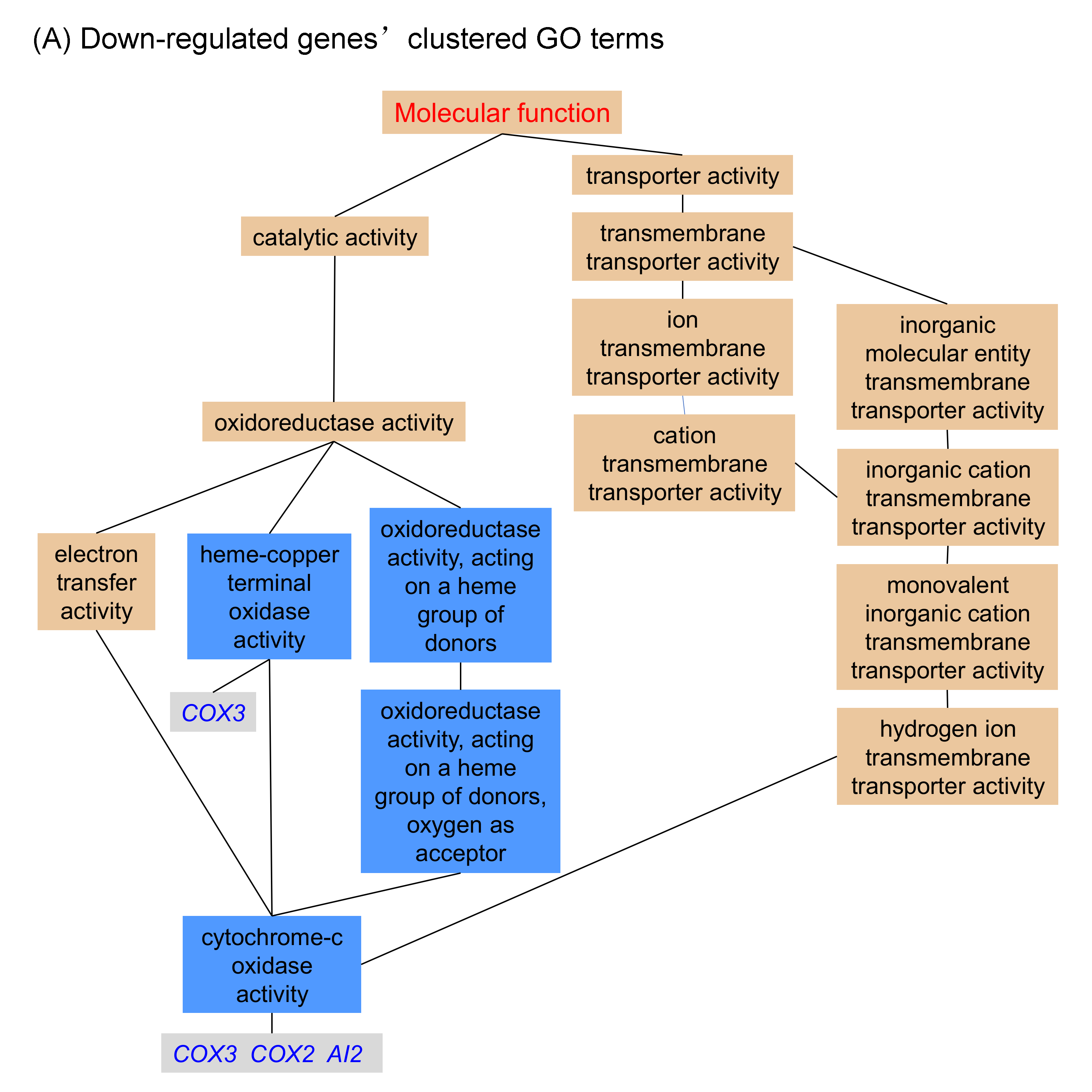Improving Xylose Fermentation in Saccharomyces cerevisiae by Expressing Nuclear-Localized Hexokinase 2
Abstract
1. Introduction
2. Materials and Methods
2.1. Yeast Strains and Plasmids
2.2. Fermentation
2.3. Analytical Methods
2.4. Transcriptome Analysis
3. Results
3.1. Nucleus-Localized Hxk2pS14A Enhances Xylose Fermentation
3.2. Deletion of MIG1 Eliminated the Effect of Nucleus-Localized Hxk2pS14A
3.3. Transcriptional Profile of the Yeast Strains Expressing Nucleus-Localized Hxk2pS14A
3.4. The Regulatory Targets of Hxk2pS14A in Cells Grown on Xylose Are Different than the Known Targets of Mig1p
4. Discussion
5. Conclusions
Supplementary Materials
Author Contributions
Funding
Acknowledgments
Conflicts of Interest
Appendix A
| Primers | Sequence5′→3′ |
|---|---|
| Hxk2p-F | CTCCAGAGCTCCACATTGGTG |
| DT-hxk2-R(S14A) | GGCACATCGGCCATGGCACCCTTTCTGGCTTG |
| DT-hxk2-F(S14A) | CAAGCCAGAAAGGGTGCCATGGCCGATGTGCC |
| HXK2-R | ATCGTCACGAATAAATCCCGTG |
| ura-1-F | CCATCTGCTCCAATGGCCATCAACTGTGAATACGG TTCCGTGATTCTGGGTAGAAGATCGGTC |
| ura-1-R | GAACCCTTGGAAGACAATTCAGC |
| ura-2-F ura-2-R | GAAACGTTGGGTCCCATACATTTG GAAAGAAAAGGTGAAACCCAATGGAATTGGCTCA GAGATACCCGAAGTTATTAGGGTCTAGAGATCCC |
| KMig-F | CAGCAGAAAAGCGCAATTGCGACACTAGCAGTGTA ACTCGTAGGTCTAGAGATCTGTTTAGCTTG |
| KMig-R | GAAGGTGGAGGCTTCACCGAGACGGGAATCTTAGC CATCGATTAAGGGTTCTCGAGAGCTC |
Appendix B

References
- Kwak, S.; Jo, J.H.; Yun, E.J.; Jin, Y.S.; Seo, J.H. Production of biofuels and chemicals from xylose using native and engineered yeast strains. Biotechnol. Adv. 2019, 37, 271–283. [Google Scholar] [CrossRef] [PubMed]
- Jansen, M.L.A.; Bracher, J.M.; Papapetridis, I.; Verhoeven, M.D.; de Bruijn, H.; de Waal, P.P.; van Maris, A.J.A.; Klaassen, P.; Pronk, J.T. Saccharomyces cerevisiae strains for second-generation ethanol production: From academic exploration to industrial implementation. FEMS Yeast Res. 2017, 17. [Google Scholar] [CrossRef] [PubMed]
- Nielsen, J. Yeast systems biology: Model organism and cell factory. Biotechnol. J. 2019, 14, e1800421. [Google Scholar] [CrossRef] [PubMed]
- Hou, J.; Qiu, C.X.; Shen, Y.; Li, H.X.; Bao, X.M. Engineering of Saccharomyces cerevisiae for the efficient co-utilization of glucose and xylose. FEMS Yeast Res. 2017, 17. [Google Scholar] [CrossRef]
- Peng, B.; Shen, Y.; Li, X.; Chen, X.; Hou, J.; Bao, X. Improvement of xylose fermentation in respiratory-deficient xylose-fermenting Saccharomyces cerevisiae. Metab. Eng. 2012, 14, 9–18. [Google Scholar] [CrossRef]
- Matsushika, A.; Watanabe, S.; Kodaki, T.; Makino, K.; Inoue, H.; Murakami, K.; Takimura, O.; Sawayama, S. Expression of protein engineered NADP+-dependent xylitol dehydrogenase increases ethanol production from xylose in recombinant Saccharomyces cerevisiae. Appl. Microbiol. Biotechnol. 2008, 81, 243–255. [Google Scholar] [CrossRef]
- Jin, Y.S.; Jeffries, T.W. Changing flux of xylose metabolites by altering expression of xylose reductase and xylitol dehydrogenase in recombinant Saccharomyces cerevisiae. Appl. Biochem. Biotechnol. 2003, 105 -108, 277–286. [Google Scholar] [CrossRef]
- Walfridsson, M.; Anderlund, M.; Bao, X.; HahnHagerdal, B. Expression of different levels of enzymes from the Pichia stipitis XYL1 and XYL2 genes in Saccharomyces cerevisiae and its effects on product formation during xylose utilisation. Appl. Microbiol. Biotechnol. 1997, 48, 218–224. [Google Scholar] [CrossRef]
- Hou, J.; Shen, Y.; Jiao, C.; Ge, R.; Zhang, X.; Bao, X. Characterization and evolution of xylose isomerase screened from the bovine rumen metagenome in Saccharomyces cerevisiae. J. Biosci. Bioeng. 2016, 121, 160–165. [Google Scholar] [CrossRef]
- Peng, B.; Huang, S.; Liu, T.; Geng, A. Bacterial xylose isomerases from the mammal gut Bacteroidetes cluster function in Saccharomyces cerevisiae for effective xylose fermentation. Microb. Cell Fact. 2015, 14, 70. [Google Scholar] [CrossRef]
- Madhavan, A.; Tamalampudi, S.; Ushida, K.; Kanai, D.; Katahira, S.; Srivastava, A.; Fukuda, H.; Bisaria, V.S.; Kondo, A. Xylose isomerase from polycentric fungus Orpinomyces: Gene sequencing, cloning, and expression in Saccharomyces cerevisiae for bioconversion of xylose to ethanol. Appl. Microbiol. Biotechnol. 2009, 82, 1067–1078. [Google Scholar] [CrossRef] [PubMed]
- Kuyper, M.; Harhangi, H.R.; Stave, A.K.; Winkler, A.A.; Jetten, M.S.M.; de Laat, W.T.A.M.; den Ridder, J.J.J.; Op den Camp, H.J.M.; van Dijken, J.P.; Pronk, J.T. High-level functional expression of a fungal xylose isomerase: The key to efficient ethanolic fermentation of xylose by Saccharomyces cerevisiae? FEMS Yeast Res. 2003, 4, 69–78. [Google Scholar] [CrossRef]
- Zhou, H.; Cheng, J.S.; Wang, B.L.; Fink, G.R.; Stephanopoulos, G. Xylose isomerase overexpression along with engineering of the pentose phosphate pathway and evolutionary engineering enable rapid xylose utilization and ethanol production by Saccharomyces cerevisiae. Metab. Eng. 2012, 14, 611–622. [Google Scholar] [CrossRef] [PubMed]
- Toivari, M.H.; Aristidou, A.; Ruohonen, L.; Penttila, M. Conversion of xylose to ethanol by recombinant Saccharomyces cerevisiae: Importance of xylulokinase (XKS1) and oxygen availability. Metab. Eng. 2001, 3, 236–249. [Google Scholar] [CrossRef]
- Garcia Sanchez, R.; Karhumaa, K.; Fonseca, C.; Sanchez Nogue, V.; Almeida, J.R.; Larsson, C.U.; Bengtsson, O.; Bettiga, M.; Hahn-Hagerdal, B.; Gorwa-Grauslund, M.F. Improved xylose and arabinose utilization by an industrial recombinant Saccharomyces cerevisiae strain using evolutionary engineering. Biotechnol. Biofuels 2010, 3, 13. [Google Scholar] [CrossRef]
- Kuyper, M.; Toirkens, M.J.; Diderich, J.A.; Winkler, A.A.; van Dijken, J.P.; Pronk, J.T. Evolutionary engineering of mixed-sugar utilization by a xylose-fermenting Saccharomyces cerevisiae strain. FEMS Yeast Res. 2005, 5, 925–934. [Google Scholar] [CrossRef]
- Scalcinati, G.; Otero, J.M.; Van Vleet, J.R.; Jeffries, T.W.; Olsson, L.; Nielsen, J. Evolutionary engineering of Saccharomyces cerevisiae for efficient aerobic xylose consumption. FEMS Yeast Res. 2012, 12, 582–597. [Google Scholar] [CrossRef]
- Kim, S.R.; Skerker, J.M.; Kang, W.; Lesmana, A.; Wei, N.; Arkin, A.P.; Jin, Y.S. Rational and evolutionary engineering approaches uncover a small set of genetic changes efficient for rapid xylose fermentation in Saccharomyces cerevisiae. PLoS ONE 2013, 8, e57048. [Google Scholar] [CrossRef]
- Shen, Y.; Chen, X.; Peng, B.; Chen, L.; Hou, J.; Bao, X. An efficient xylose-fermenting recombinant Saccharomyces cerevisiae strain obtained through adaptive evolution and its global transcription profile. Appl. Microbiol. Biotechnol. 2012, 96, 1079–1091. [Google Scholar] [CrossRef]
- Osiro, K.O.; Borgstrom, C.; Brink, D.P.; Fjolnisdottir, B.L.; Gorwa-Grauslund, M.F. Exploring the xylose paradox in Saccharomyces cerevisiae through in vivo sugar signalomics of targeted deletants. Microb. Cell Fact. 2019, 18, 88. [Google Scholar] [CrossRef]
- Fernandez-Garcia, P.; Pelaez, R.; Herrero, P.; Moreno, F. Phosphorylation of yeast hexokinase 2 regulates its nucleocytoplasmic shuttling. J. Biol. Chem. 2012, 287, 42151–42164. [Google Scholar] [CrossRef] [PubMed]
- Conrad, M.; Schothorst, J.; Kankipati, H.N.; Van Zeebroeck, G.; Rubio-Texeira, M.; Thevelein, J.M. Nutrient sensing and signaling in the yeast Saccharomyces cerevisiae. FEMS Microbiol. Rev. 2014, 38, 254–299. [Google Scholar] [CrossRef] [PubMed]
- Salusjarvi, L.; Kankainen, M.; Soliymani, R.; Pitkanen, J.P.; Penttila, M.; Ruohonen, L. Regulation of xylose metabolism in recombinant Saccharomyces cerevisiae. Microb. Cell Fact. 2008, 7, 18. [Google Scholar] [CrossRef]
- Brink, D.P.; Borgstrom, C.; Tueros, F.G.; Gorwa-Grauslund, M.F. Real-time monitoring of the sugar sensing in Saccharomyces cerevisiae indicates endogenous mechanisms for xylose signaling. Microb. Cell Fact. 2016, 15, 183. [Google Scholar] [CrossRef] [PubMed]
- Wu, M.; Li, H.; Wei, S.; Wu, H.; Wu, X.; Bao, X.; Hou, J.; Liu, W.; Shen, Y. Simulating extracellular glucose signals enhances xylose metabolism in recombinant Saccharomyces cerevisiae. Microorganisms 2020, 8. [Google Scholar] [CrossRef] [PubMed]
- Vega, M.; Riera, A.; Fernandez-Cid, A.; Herrero, P.; Moreno, F. Hexokinase 2 is an intracellular glucose sensor of yeast cells that maintains the structure and activity of Mig1 protein repressor complex. J. Biol. Chem. 2016, 291, 7267–7285. [Google Scholar] [CrossRef]
- Chang, S.F.; Ho, N.W. Cloning the yeast xylulokinase gene for the improvement of xylose fermentation. Appl. Biochem. Biotechnol. 1988, 17, 313–318. [Google Scholar] [CrossRef]
- Moreno, F.; Ahuatzi, D.; Riera, A.; Palomino, C.A.; Herrero, P. Glucose sensing through the Hxk2-dependent signalling pathway. Biochem. Soc. T 2005, 33, 265–268. [Google Scholar] [CrossRef]
- Bergdahl, B.; Sandstrom, A.G.; Borgstrom, C.; Boonyawan, T.; van Niel, E.W.; Gorwa-Grauslund, M.F. Engineering yeast hexokinase 2 for improved tolerance toward xylose-induced inactivation. PLoS ONE 2013, 8, e75055. [Google Scholar] [CrossRef][Green Version]
- Heidrich, K.; Otto, A.; Behlke, J.; Rush, J.; Wenzel, K.W.; Kriegel, T. Autophosphorylation-inactivation site of hexokinase 2 in Saccharomyces cerevisiae. Biochemistry 1997, 36, 1960–1964. [Google Scholar] [CrossRef]
- Rolland, F.; De Winde, J.H.; Lemaire, K.; Boles, E.; Thevelein, J.M.; Winderickx, J. Glucose-induced cAMP signalling in yeast requires both a G-protein coupled receptor system for extracellular glucose detection and a separable hexose kinase-dependent sensing process. Mol. Microbiol. 2000, 38, 348–358. [Google Scholar] [CrossRef] [PubMed]
- Li, H.; Shen, Y.; Wu, M.; Hou, J.; Jiao, C.; Li, Z.; Liu, X.; Bao, X. Engineering a wild-type diploid Saccharomyces cerevisiae strain for second-generation bioethanol production. Bioresour. Bioprocess. 2016, 3, 51. [Google Scholar] [CrossRef] [PubMed]
- Gueldener, U.; Heinisch, J.; Koehler, G.J.; Voss, D.; Hegemann, J.H. A second set of loxP marker cassettes for Cre-mediated multiple gene knockouts in budding yeast. Nucleic Acids Res. 2002, 30, e23. [Google Scholar] [CrossRef] [PubMed]
- Monteiro, P.T.; Oliveira, J.; Pais, P.; Antunes, M.; Palma, M.; Cavalheiro, M.; Galocha, M.; Godinho, C.P.; Martins, L.C.; Bourbon, N.; et al. YEASTRACT+: A portal for cross-species comparative genomics of transcription regulation in yeasts. Nucleic Acids Res. 2020, 48, D642–D649. [Google Scholar] [CrossRef] [PubMed]
- Myers, K.S.; Riley, N.M.; MacGilvray, M.E.; Sato, T.K.; McGee, M.; Heilberger, J.; Coon, J.J.; Gasch, A.P. Rewired cellular signaling coordinates sugar and hypoxic responses for anaerobic xylose fermentation in yeast. PLoS Genet. 2019, 15, e1008037. [Google Scholar] [CrossRef] [PubMed]
- Sato, T.K.; Tremaine, M.; Parreiras, L.S.; Hebert, A.S.; Myers, K.S.; Higbee, A.J.; Sardi, M.; McIlwain, S.J.; Ong, I.M.; Breuer, R.J.; et al. Directed evolution reveals unexpected epistatic interactions that alter metabolic regulation and enable anaerobic xylose use by Saccharomyces cerevisiae. PLoS Genet. 2016, 12. [Google Scholar] [CrossRef]
- Fernandez, R.; Herrero, P.; Fernandez, M.T.; Moreno, F. Mechanism of inactivation of hexokinase PII of Saccharomyces cerevisiae by D-xylose. Microbiology 1986, 132, 3467–3472. [Google Scholar] [CrossRef]





| Strain and Plasmids | Description | Source |
|---|---|---|
| YEp-CH | YEp24 derivative; GAL1p-Cre-CYC1t, TEF1p-hygB-TEF1t | [32] |
| pJX7 | 2μori, URA3, TEF1p-RuXI-PGK1t | [9] |
| pUG72 | 2μori, Ampr, loxP-KIURA3p-KIURA3-KIURA3t-loxP | [33] |
| BSPC039 | CEN.PK113-5D derivative; MATa; ura3-52XKS1(-194, -1)::loxP-TEF1p, gre3(-241, +338):: TPI1p-RKI1-RKI1t-PGK1p-TAL1-TAL1t-FBA1p-TKL1-TKL1t-ADH1p-RPE1-RPE1t-loxP | [5] |
| BSL01 | BSPC039 derivative; pJX7 | [25] |
| BSHA01 | BSPC039 derivative; HXK2S14A, pJX7 | This work |
| BSHM01 | BSL01 derivative; mig1Δ, pJX7 | This work |
| BSHM02 | BSHA01 derivative; mig1Δ; HXK2S14A, pJX7 | This work |
| Strains (Genotype) | μ (h−1) | rxylose (g L−1 h−1) | rethanol (g L−1 h−1) | Yethanol (g g−1 xylose) |
|---|---|---|---|---|
| BSL01 (Wild type) | 0.153 ± 0.003 | 0.276 ± 0.034 | 0.066 ± 0.003 | 0.194 ± 0.015 |
| BSHA01 (HXK2S14A) | 0.163 ± 0.008 | 0.341 ± 0.027* | 0.118 ± 0.002* | 0.277 ± 0.032* |
| BSHM01 (mig1Δ) | 0.155 ± 0.010 | 0.205 ± 0.010* | 0.036 ± 0.004* | 0.135 ± 0.023* |
| BSHM02 (HXK2S14A; mig1Δ) | 0.145 ± 0.047 | 0.200 ± 0.024* | 0.050 ± 0.014* | 0.169 ± 0.035 |
| GO Term (GO ID) | Up-Regulated Genes | Down-Regulated Genes |
|---|---|---|
| generation of precursor metabolites and energy (GO:0006091) | - | ADH4, AI2, COX2, TKL2 |
| cellular respiration (GO:0045333) | - | AI2, COX2, COX3 |
| carbohydrate metabolic process (GO:0005975) | XKS1 | GPP1 |
| carbohydrate transport (GO:0008643) | - | HXT5 |
| monocarboxylic acid metabolic process (GO:0032787) | - | ALD3 |
© 2020 by the authors. Licensee MDPI, Basel, Switzerland. This article is an open access article distributed under the terms and conditions of the Creative Commons Attribution (CC BY) license (http://creativecommons.org/licenses/by/4.0/).
Share and Cite
Zheng, L.; Wei, S.; Wu, M.; Zhu, X.; Bao, X.; Hou, J.; Liu, W.; Shen, Y. Improving Xylose Fermentation in Saccharomyces cerevisiae by Expressing Nuclear-Localized Hexokinase 2. Microorganisms 2020, 8, 856. https://doi.org/10.3390/microorganisms8060856
Zheng L, Wei S, Wu M, Zhu X, Bao X, Hou J, Liu W, Shen Y. Improving Xylose Fermentation in Saccharomyces cerevisiae by Expressing Nuclear-Localized Hexokinase 2. Microorganisms. 2020; 8(6):856. https://doi.org/10.3390/microorganisms8060856
Chicago/Turabian StyleZheng, Liyuan, Shan Wei, Meiling Wu, Xuehao Zhu, Xiaoming Bao, Jin Hou, Weifeng Liu, and Yu Shen. 2020. "Improving Xylose Fermentation in Saccharomyces cerevisiae by Expressing Nuclear-Localized Hexokinase 2" Microorganisms 8, no. 6: 856. https://doi.org/10.3390/microorganisms8060856
APA StyleZheng, L., Wei, S., Wu, M., Zhu, X., Bao, X., Hou, J., Liu, W., & Shen, Y. (2020). Improving Xylose Fermentation in Saccharomyces cerevisiae by Expressing Nuclear-Localized Hexokinase 2. Microorganisms, 8(6), 856. https://doi.org/10.3390/microorganisms8060856





